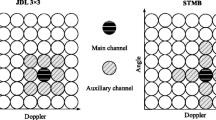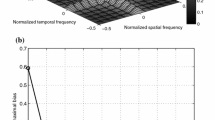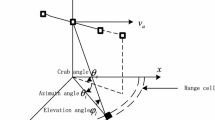Abstract
Direct data domain (DDD) space-time adaptive processing methods avoid nonhomogenerous training samples and can effectively suppress the clutter within the test range cell. However, it suffers inevitable performance loss due to the spatial and temporal smoothing process. Furthermore, the clutter suppression ability of these methods sharply degrades when applied to non-uniform and non-linear array for airborne radar. In this paper, a novel clutter suppression approach in the direct data domain is proposed, which describes clutter characteristic of the test range cell with AR model. For convenience, the novel method is referred to as \(\hbox {D}^{3}\hbox {AR}\). It utilizes the most system DOF. Hence, it suffers less aperture loss, compared to conventional DDD methods, e.g., the direct data domain least squares (\(\hbox {D}^{3}\hbox {LS}\)). More importantly, \(\hbox {D}^{3}\hbox {AR}\) can achieve much better clutter suupression prformance than \(\hbox {D}^{3}\hbox {LS}\) when applied to conformal array airborne radar because it does not need the spatial smoothing. The effectiveness of the \(\hbox {D}^{3}\hbox {AR}\) is verified by numerical examples for the case of a circular array.









Similar content being viewed by others
References
Befgin, J. S., Teixeira, C. M., Techau, P. M., et al. (2006). Improved clutter mitigation performance using knowledge-aided space-time adaptive processing. IEEE Transactions on Aerospace and Electronic Sytems, 42, 997–1009.
Carlson, B. D. (1988). Covariance matrix estimation errors and diagonal loading in adaptive arrays. IEEE Transactions on Aerospace and Electronic systems, 24, 397–401.
Gerlach, K. (1995). The effects of signal contamination on two adaptive detectors. IEEE Transactions on Aerospace and Electronic Systems, 30, 297–309.
Gerlach, K. R. (2002). Outlier resistant adaptive matched filtering. IEEE Transactions on Aerospace and Electronic Systems, 38, 885–901.
Gerlach, K., & Picciolo, M. L. (2003). Airborne/spacebased radar STAP using a structured covariance matrix. IEEE Transactions on Aerospace and Electronic Sytems, 39, 269–281.
Goodman, N. A., & Stiles, J. M. (2007). On clutter rank observed by arbitrary arrays. IEEE Transactions on Signal processing, 55, 178–186.
Klemm, R. (2000). Comparison between monostatic and bistatic antenna configurations for STAP. IEEE Transactions on Aerospace and Electronic Systems, 36, 596–608.
Klemm, R. (2002). Principles of space-time adaptive processing. London: IEE Press.
Lapierre, F., Droogenbroeck, M., & Verly, J. (2003). New solutions to the problem of range dependence in bistatic STAP radars. In Proceedings of the IEEE national radar conference, pp. 452–459.
Melvin, W., Himed, B., & Davis, M. (2003). Doubly adaptive bistatic clutter filtering. In Proceedings of the IEEE national radar conference, pp. 171–178.
Melvin, W., Wicks, M., Antonik, P., et al. (1998). Knowledge-based space-time adaptive processing for airborne early warning radar. IEEE Transactions on Aerospace and Electronic Sytems, 24, 37–42.
Melvin, W. L. (2000). Space-time adaptive radar performance in heterogeneous clutter. IEEE Transactions on Aerospace and Electronic Systems, 30, 621–633.
Parker, P., & Swindlehurst, A. (2003). Space-time autoregressive filtering for matched subspace STAP. IEEE Transactions on Aerospace and Electronic Sytems, 39, 510–520.
Rabideau, D. J., & Steinhardt, A. O. (1996). Improving the performance of adaptive arrays in non-stationary environments through data-adaptive training. In Proceedings of the Asilomar conference, pp. 75–79. Pacific Grove, CA.
Reed, I. S., Mallett, S. D., & Brennan, L. E. (1974). Rapid convergence rate in adaptive arrays. IEEE Transactions on Aerospace and Electronic Systems, 10, 853–863.
Roman, J. R., Rangaswamy, M., Davis, D. W., et al. (2000). Parametric adaptive matched filter for airborne radar applications. IEEE Transactions on Aerospace and Electronic Sytems, 36, 677–692.
Sarkar, T. K., Wang, H., Park, S., Koh, J., Adve, R., Kim, K., et al. (2001). A deterministic least squares approach to space time adaptive processing (STAP). IEEE Transactions on Antennas and Propagation, 49, 91–103.
Wang, Y. L., Peng, Y. N., & Bao, Z. (1997). Space-time adaptive processing for airborne radar with various array orientations. IET Radar, Sonar and Navigation, 144, 330–340.
Ward, J. (1994). Space-time adaptive processing for airborne radar. MIT Lincoln Laboratory Technical Report. ESC-TR-94-109, 13 December 1994.
Xie, W. C., & Wang, Y. L. (2009). STAP for airborne radar with cylindrical phased array antennas. Signal Processing, 89, 883–893.
Zatman, M. (2000). Circular array STAP. IEEE Transactions on Aerospace and Electronic Systems, 36, 510–517.
Zhao, L., Sun, J. P., & Xu, X. J. (2014). A hybrid STAP approach to target detection for heterogeneous scenarios in radar seekers. Multidimensional systems and signal processing, 25, 493–509.
Acknowledgments
This work was supported in part by the National Nature Science Foundation of China under Contract 61102169.
Author information
Authors and Affiliations
Corresponding author
Rights and permissions
About this article
Cite this article
Duan, K., Xie, W., Wang, Y. et al. A deterministic auto-regressive STAP approach for nonhomogenerous clutter suppression. Multidim Syst Sign Process 27, 105–119 (2016). https://doi.org/10.1007/s11045-014-0292-5
Received:
Revised:
Accepted:
Published:
Issue Date:
DOI: https://doi.org/10.1007/s11045-014-0292-5




